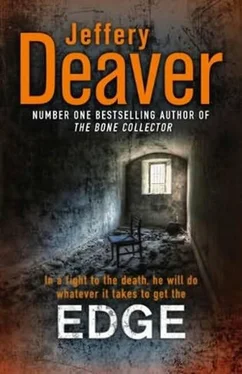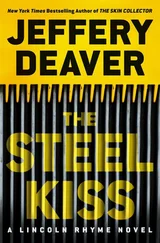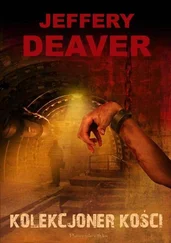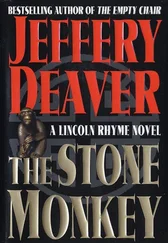Joanne said, “I’m not talking about Andrew. I found something else. Look.” She spun the computer toward us. I saw the Global Software Innovations logo on the screen, as Joanne opened folders with the editing and archiving software. She called up some of her sister’s recent photographs-the series in downtown D.C., which included the pictures I had helped her choose from. She paused at another image, one I’d looked at but had paid no attention to. It was also of two men, engaged in a serious conversation, as they sat at an outdoor café somewhere near the Mall. One appeared to be in his late fifties, the other about twenty years younger. The background was blurred-intentionally out of focus, I judged-and the intense faces of the men took the viewer’s attention.
“You see anything unusual?” Joanne asked.
I studied the picture carefully. Then I noticed that the older man was dropping something into the hand of the younger one. It was impossible to see for certain what it might be. But it looked like a thumb drive for a computer. I asked her if that’s what she meant.
“Yes.”
“So?” Ryan asked.
His wife continued, “Don’t you recognize the older man?”
“No,” I said. “Should I?”
Ryan shook his head.
“Martin Allende. He was on the news last week.” Joanne explained that he was a Colombian diplomat suspected of laundering al Qaeda money through banks in his country.
I took her word for it. I had only a vague memory of a passing news report.
Joanne added that the story reported no charges could be brought because authorities couldn’t find a trail to the terrorists or offshore banks. “Maree got a picture of him with his contact-the younger man,” she raged. I saw her hands were shaking in anger. “That’s why they’re after her. To get her camera, computer, find out if she made any copies, see if she took any more pictures. The terrorist cell is worried that somebody in national security-the CIA, the FBI, Intelligence Assessment-could identify who Allende’s with. Remember the man who bumped into Maree, knocked her down? I bet it was to grab something from her purse, find out her address.”
I looked closely at the picture. I leaned over, plugged a cable into her computer and downloaded the picture to my phone, wrote out instructions to duBois and uploaded the email with the phone.
Joanne was sitting forward. The numbness masking her face all weekend was now gone. She was furious, her face flushed, eyes flaring. “My little innocent sister poking her nose where it doesn’t belong… Does she ever use her fucking brain? What did she think would happen when she started taking pictures of people in public? Did she ever think that might be a stupid idea?”
I wondered if she was heading for the predicted breakdown. She’d bottled her feelings up since Saturday morning. The explosion loomed. I’d seen it happen dozens of times.
“We’ll find out,” I said, nodding at the phone.
“She never thinks there could be consequences… And who’s taking the shit? Us. Our daughter was almost killed because of her! Because I took her in. No good deed goes unpunished, right? I didn’t even want her in my house. It’s been the worst month of my life. She lectures about the sanctity of art but she can’t even afford to pay for the food she eats. Ever since she moved in, Ryan and I’ve been at each other’s throats. It’s been a fucking nightmare.”
“Jo,” her husband said.
She snapped, “I should let her go back to Andrew. They fucking deserve each other. Let him beat some sense into her.”
A piercing alarm made us all start. Ryan reached for his weapon and I went for mine. Though I recognized the tone; it wasn’t a break-in but the emergency door release. Somebody inside had hit it, to get out.
Ahmad appeared immediately, holding a black M4 Bushmaster, the stock racked short, his finger outside the trigger guard. Tony Barr, pistol in hand, was behind him.
I held up a hand.
“Oh, no,” Joanne whispered, eyes wide. She was looking out the window to the side porch, where Maree stood, staring back through the glass. The younger sister had heard every hard word uttered about her. Her face, twisted in pain, continued to stare for a moment. Then she turned away and fled down the porch and over the lawn toward the woods.
“No, please! Maree! No!” Joanne leapt up.
“Stay here,” I said firmly. I told Ahmad and Barr to secure the principals and sprinted outside, tucking my gun away.
THE DEA AGENT I became friendly with in Texas told me that when sign cutting and tracking, it helps to know the goal of the person you’re pursuing.
Some of the people you’re after have in mind nothing more than being anywhere that you’re not. They’ll escape wherever they can, however they can.
Those are the hardest to track.
The easiest to find are those who have a destination that you know or can deduce.
I believed Maree had such a place in mind. I needed to find her path, though, because there were a number of specific places she might head for. I absolutely had to get there before she did. I paused at the edge of the forest and looked around me, at the puzzle of tree trunks and branches and foliage. Much of the greenery had been cut away to provide a clear view around the house, a perimeter for security purposes. But beyond that, a lot of the area was impenetrable.
I spotted overturned branches, leaves disturbed, pebbles slightly out of place and then a few good prints from stylish shoes. I began to sprint.
A hundred yards into the trees, I gave up on looking for sign. I no longer needed to, since I heard Maree pushing relentlessly through the brush. That wasn’t all I heard. Growing in my ears was a roar-bearing out my deduction about where she was headed.
A few moments later I broke from the woods into a clearing and saw the young woman ahead of me-knowing how to move quickly through the foliage, I’d closed the distance but she was still a hundred feet away.
Looking back she saw me and stopped.
As a shepherd I’ve pursued many people until they cease running. Usually it’s because they’ve run out of feasible routes or out of gasoline or physical stamina.
On occasion they stopped simply because they’d reached their destination.
Maree was on the edge of a rock cliff overlooking the source of the noise: the Potomac River. The woman who had twice tried to kill herself was looking down at the water cascading over the stones below. It was only thirty or forty feet to the surface but the river here was strewn with rocks and the current was swift and deep.
This seemed the perfect setting for somebody who wished to take her life. I moved in closer, slowly. I didn’t want her to spook.
She sat down, looked back at me with a hollow, red face. And slipped over the edge.
I gasped and ran forward.
But then her head emerged and I realized she’d slid down to a rocky outcropping below the side of the cliff. She was just sitting there, on a shelf jutting over the boulders and speedy water.
I continued forward slowly, noticing some people on the distant shore of the river, tourists strolling along the path there, which bordered the Chesapeake and Ohio Canal, which travels all the way from Georgetown to Cumberland, Maryland.
I got to the edge and looked down at the turbulent brown and gray water, the froth, the shiny rocks. To my right, Maree was huddled on the ledge, legs crossed like a yoga practitioner’s.
“Maree,” I said.
She was fiddling with her camera. I moved in closer and made sure she saw my slow, unthreatening transit toward her. I stopped when I was about twenty feet away, at the top of the cliff, and also sat-partly so that I wouldn’t be seen as a threat and partly because I myself am not a great fan of heights. She glanced toward me and turned her attention back to the Canon. She lifted it and took some panoramic pictures of the view, then aimed down at the rocks below her. Then, curiously, she turned the lens to her face, which was puffy and damp with tears. Hopeless.
Читать дальше












